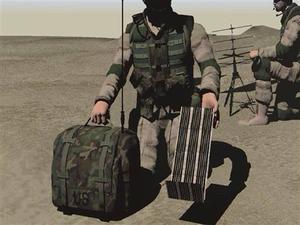DARPA looking for solar cells that can withstand the rigors of war
DARPA is investing $3.8 million into the creation of high-powered, lightweight solar cells that can “stand up to battle conditions and environmental extremes”; thin-film, flexible solar cells are a major priority for the military, because they can be applied onto almost everything — from tents to uniforms — and would minimize the number of generators and portable battery packs needed by troops in battle

Illustration of solar panel deployment in the field // Source: msn.com
For years, the U.S. military has made on-again, off-again attempts to find eco-friendly ways to get power war-zones, bases, and drones. Lately, they have seemed willing to try almost anything to do it. In the last year alone, the military has funded projects that tried to turn ocean water into liquid fuel and use dye inspired by purple bacteria to charge UAVs.
Katie Drummond writes that now DARPA, the agency behind the Pentagon’s most out-there ideas, is putting its money into an old standby: solar power. They are investing $3.8 million into the creation of high-powered, lightweight solar cells that can “stand up to battle conditions and environmental extremes.”
The program, called Low-Cost Lightweight Portable Photovoltaics (PoP), is being spearheaded by Dr. Robert Birkmire, director of the University of Delaware’s Institute of Energy Conversion (IEC). The Institution has a long history of working on DARPA-funded projects, including a 7-year consortium, launched in 1995, which successfully created much of the tech now going into PoP.
“Obviously, this is an agency that sets out some incredibly ambitious goals,” Birkmire told Drummond. “But if you’d asked me in 1995, if we’d be able to complete that project? I’d have had no idea.”
Birkmire is also quick to point out that the cells DARPA is after will require some lofty innovation. Thin-film, flexible solar cells are a major priority for the military, because they can be applied onto almost everything — from tents to uniforms — and would minimize the number of generators and portable battery packs needed by troops in battle. In 2005 the U.S. Army tested tents lined with silicon-based solar cells that were able to generate adequate power for fans, lap tops and lights.
Five years later, Birkmire and colleagues have taken that technology up a notch. They are testing cutting edge, copper-indium-deselinide-based cells, made on a lightweight plastic substrate. DARPA wants the PoP program to yield solar cells that are more than just light and flexible — they should also be able to withstand dirt, rough handling and punctures, and be manufactured inexpensively.
Right now, Birkmire said, the cells are in their infancy, and operate at 7-11 percent efficiency. DARPA wants to see that doubled — at least.
“They want to take performance to another level, and I’m not sure that we’ll get there,” he said of the program, which will also include four industry partners. “Add to that the challenge of encapsulating these models to make them resilient for battle, and keeping them lightweight in spite of that, and it’s a big challenge.”
Because the cells are so inexpensive (less than $1/watt), and so versatile, Birkmire anticipates widespread civilian application. “It’s a perfect example of what can be great about Darpa programs,” he said. “This is research and tech that’ll have larger implications.”
